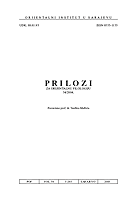Vakufi u Rogatici do kraja 16. stoljeća
Waqfs in Rogatica until the end of the 16th century
Author(s): Amina KupusovićSubject(s): History
Published by: Orijentalni Institut u Sarajevu
Summary/Abstract: This paper gives information about waqfs - endowments in the town of Rogatica, which in the Ottoman time was called Chelebi Pazar. The paper is primarily based on information contained in the Ottoman property registers - tapu tahrir defteri. On the basis thereof, it was established that in Chelebi Pazar in the 16th century a considerable number of buildings had been erected or the upkeep of which waqfs were left in the form of useful buildings such as shops, public baths and houses, real estate such as land and cash which used to be given as loans. As such, remarkable were Imperial Mosques as not classical forms of the waqf in the Ottoman State. Sultan Bayazid had the first mosque Sultan's endowments, which, although they were recorded in the register as waqfs, were built in Chelebi Pazar, and for its maintenance and salaries of its employees a sum was fixed from the poll-tax of the Visegrad qadilik. Chelebi Pazar's greatest benefactors were, along with Sultans Bayazid and Selim II, tanner Alija, son of Bajramlija, Ilijas Arnaut, Sinan-voivoda, Hussein-beg, son of Ilijas, Hatidza-hatun, his wife, and Mihri-hatun, his sister. Those personali-ties with their waqfs made Chelebi Pazar one of the most developed towns in the 16th century.
Journal: Prilozi za orijentalnu filologiju
- Issue Year: 2005
- Issue No: 54
- Page Range: 169-180
- Page Count: 12
- Language: Bosnian

